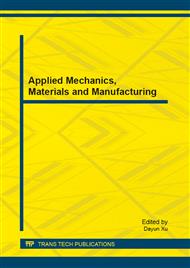p.102
p.109
p.115
p.121
p.125
p.131
p.135
p.140
p.145
Illumination Time Dependent Degradation of C60 Solar Cell Efficiencies
Abstract:
In contrast to the solar cells based on inorganic semiconductors, organic solar cells degrade during illumination. Therefore, the influence of the illumination time on the efficiencies of an organic solar cell is investigated which reveals that under steady-state illumination at 1 sun (100 mW/cm2) the efficiency of the solar cell with the structure of ITO/CuPc/C60/BCP/Ag degrade significantly over few hours. There are three efficiencies that are of interest; Fill Factor (FF), Power Conversion Efficiency (PCE), and Quantum Yield (QY). Fill factor decreased less than power conversion efficiency and quantum yield, indicating that the degradation in those efficiencies is caused by photon-induced damage to the molecules that did not lead to an increase in internal resistance.
Info:
Periodical:
Pages:
125-130
Citation:
Online since:
August 2013
Authors:
Keywords:
Price:
Сopyright:
© 2013 Trans Tech Publications Ltd. All Rights Reserved
Share:
Citation:



